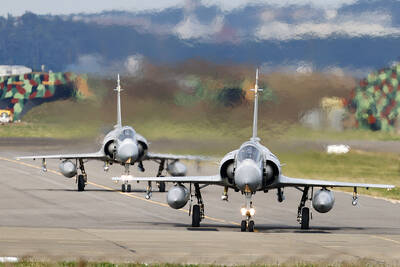The latest computerized scenario carried out by the military showed that in a war with China, Taipei would be occupied by enemy forces in just three days, a magazine report said yesterday.
Last month’s simulation, attended by President Ma Ying-jeou (馬英九), came amid warnings that China was expected to increase the number of its missiles aimed at Taiwan by several hundred to more than 1,900 by the end of this year. These include ballistic missiles, cruise missiles and other weaponry deployed throughout China.
Under the scenario, which assumed war at next year’s force levels, the People’s Liberation Army (PLA) launched intensive air raids on Taiwan before sending in ground troops from the sea and air, the Chinese-language Next Magazine reported.
The drill found that Chinese troops could march into Taipei on the third day of hostilities, seizing control of top military command facilities and the Presidential Office, Next said, quoting unnamed sources.
The results were a severe blow to Ma’s goal of building “solid defense and efficient deterrence” with a small but elite army, the magazine said.
During his presidential campaign, Ma vowed to build a stronger military as a deterrent against aggression by Beijing. Under Ma’s plan, Taipei has worked to achieve an all-volunteer force, but this will come at great cost to the defense budget, which is set at US$9.3 billion this year, a 6.9 percent drop from last year’s US$9.6 billion and US$10.5 billion in 2008.
The military must also cope with a number of aging defense systems that are due for refurbishing or replacement, including its F-16A/B fighter aircraft.
The Ministry of National Defense dismissed Next’s report.
The conclusion to this year’s scenario would be a dramatic departure from the computer simulation segment of the Han Kuang exercises held in June last year, in which, after seeing the air force and navy annihilated by PLA forces, reorganized army forces managed to mop up the eight divisions of Chinese soldiers that landed in the southern, central and northern parts of the country.
Last year’s scenario also did not factor in the possibility of decapitation attacks by the PLA, which had figured, albeit controversially, in previous years’ exercises.
Since Ma took office, the live-fire exercises accompanying the computer simulations have been canceled or downsized, which many have seen as a concession to rapprochement efforts. The military has also been instructed to prepare for humanitarian assistance and natural disasters over the possibility of a Chinese invasion.
In recent years, defense analysts have raised the specter of a shift in the balance of power in the Taiwan Strait, fears that stem from the US’ reluctance to sell Taipei advanced weaponry and years of double-digit growth in the declared PLA annual military budget. Recent reports conclude that the balance has now shifted in Beijing’s favor.
Under US-Taiwan security pacts, Taiwan’s military would be expected to hold off a Chinese invasion for 10 days to two weeks before US forces could intervene.

Taiwan is gearing up to celebrate the New Year at events across the country, headlined by the annual countdown and Taipei 101 fireworks display at midnight. Many of the events are to be livesteamed online. See below for lineups and links: Taipei Taipei’s New Year’s Party 2026 is to begin at 7pm and run until 1am, with the theme “Sailing to the Future.” South Korean girl group KARA is headlining the concert at Taipei City Hall Plaza, with additional performances by Amber An (安心亞), Nick Chou (周湯豪), hip-hop trio Nine One One (玖壹壹), Bii (畢書盡), girl group Genblue (幻藍小熊) and more. The festivities are to

Auckland rang in 2026 with a downtown fireworks display launched from New Zealand’s tallest structure, Sky Tower, making it the first major city to greet the new year at a celebration dampened by rain, while crowds in Taipei braved the elements to watch Taipei 101’s display. South Pacific countries are the first to bid farewell to 2025. Clocks struck midnight in Auckland, with a population of 1.7 million, 18 hours before the famous ball was to drop in New York’s Times Square. The five-minute display involved 3,500 fireworks launched from the 240m Sky Tower. Smaller community events were canceled across New Zealand’s

‘IRRESPONSIBLE’: Beijing’s constant disruption of the ‘status quo’ in the Taiwan Strait has damaged peace, stability and security in the Indo-Pacific region, MOFA said The Presidential Office yesterday condemned China’s launch of another military drill around Taiwan, saying such actions are a “unilateral provocation” that destabilizes regional peace and stability. China should immediately stop the irresponsible and provocative actions, Presidential Office spokeswoman Karen Kuo (郭雅慧) said, after the Chinese People’s Liberation Army (PLA) yesterday announced the start of a new round of joint exercises around Taiwan by the army, navy and air force, which it said were approaching “from different directions.” Code-named “Justice Mission 2025,” the exercises would be conducted in the Taiwan Strait and in areas north, southwest, southeast and east of Taiwan

UNDER WAY: The contract for advanced sensor systems would be fulfilled in Florida, and is expected to be completed by June 2031, the Pentagon said Lockheed Martin has been given a contract involving foreign military sales to Taiwan to meet what Washington calls “an urgent operational need” of Taiwan’s air force, the Pentagon said on Wednesday. The contract has a ceiling value of US$328.5 million, with US$157.3 million in foreign military sales funds obligated at the time of award, the Pentagon said in a statement. “This contract provides for the procurement and delivery of 55 Infrared Search and Track Legion Enhanced Sensor Pods, processors, pod containers and processor containers required to meet the urgent operational need of the Taiwan air force,” it said. The contract’s work would be